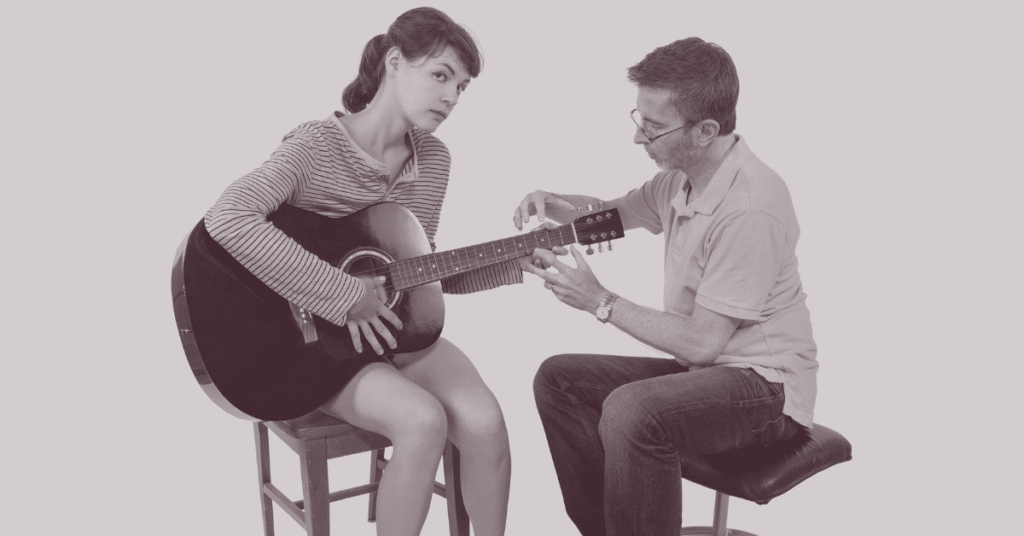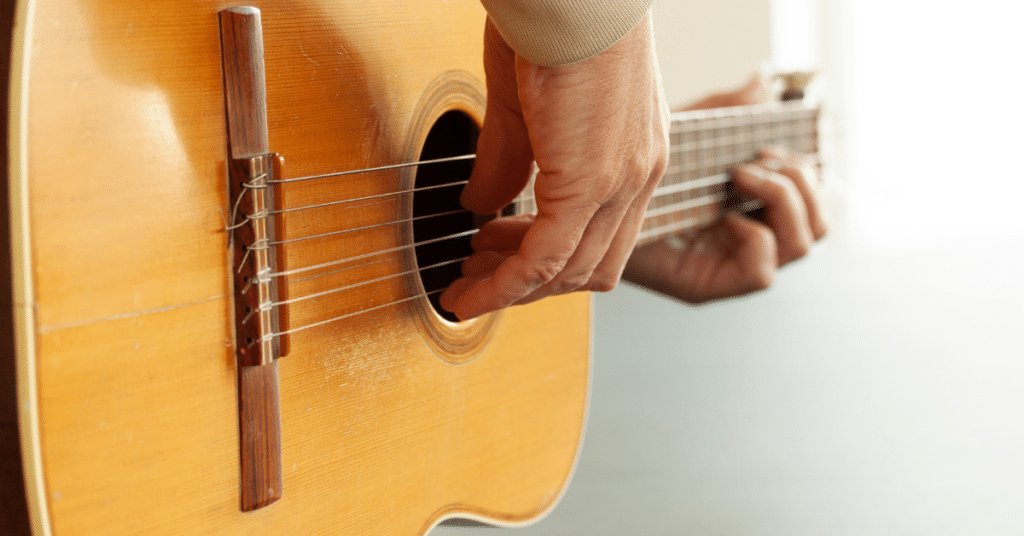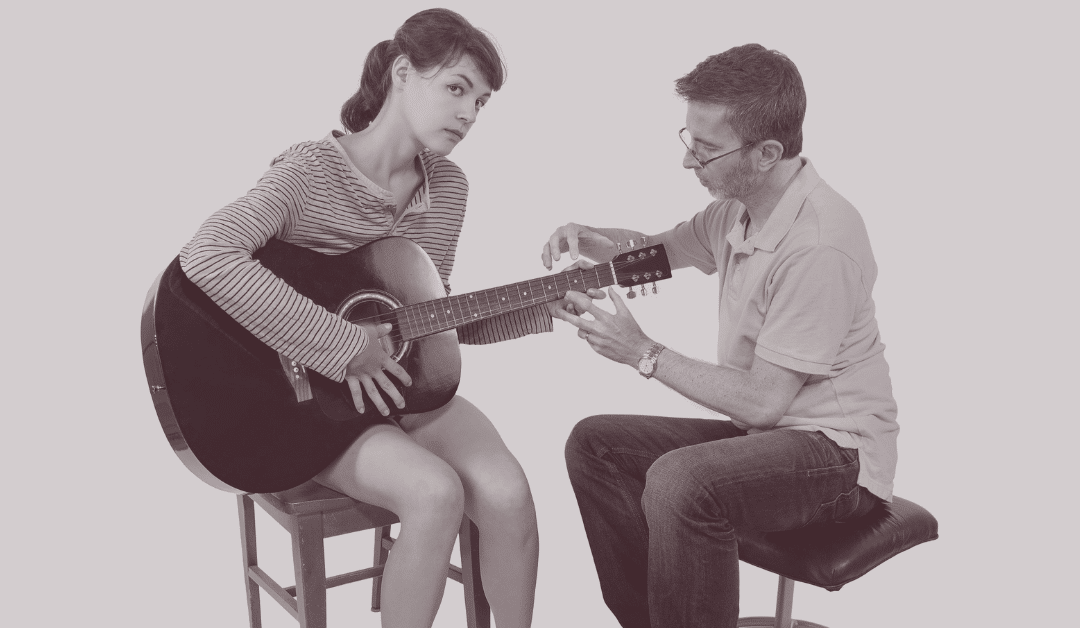Searching for some quick ways to learn to play guitar? Learning to play the guitar is complicated when you don’t know where to start, but it doesn’t have to be.
At first, when faced with the content of a course or learning guide, it may seem less than exciting to be confronted with an endless path of music theory and boring lessons.
In this way, we can take some shortcuts and use specific tools that will facilitate the process, and that, after a few practices, can enable us to play some songs without the need to spend a lot of time studying.
Guitar basics
The guitar is a plucked string instrument that you can use to construct harmonic bases, rhythmic bases, and melodic lines. It is a versatile instrument since it provides various tools for interpreting a musical piece and adapts to the execution of varied musical styles.
It is common to find this instrument in most popular music compositions. Being the guitar is an indispensable tool for composition and improvisation.
In the same way, and thanks to the popularity that the guitar has acquired in music in general, it is common to find people taking their first steps in music with this instrument and then move on to others of specific character and sonorities.
So, suppose we decide to start playing the guitar. In that case, we should know that it is widespread among the community of musicians. Because of this, every day, we can get new techniques and variations that make the instrument a world of endless possibilities.

The guitar versus other instruments
The guitar requires dedication. If you want an instrument to start playing that doesn’t need as much time to achieve proficient playing skills, you may be better off with the ukulele.
However, in terms of sound and performance, the guitar meets the requirements of many music needs, while other instruments are only limited to its narrow range of qualities.
For example, it is uncommon to find a violinist playing chords on his instrument or a bassist playing the bass’s melodic line.
So, while the guitar may not be the instrument that everyone needs, it is the instrument that everyone should know. Similarly, you can look for some other instruments that may be just as versatile, but the level of difficulty and the hours of practice required could increase considerably.
Why is it so difficult to learn to play guitar?
When you have no previous experience on any instrument learning from scratch will always seem like a difficult task, especially if you expect to play a song anytime soon. Unlike stringed instruments, wind instruments or percussion instruments, the guitar does not require much mobility of the body but of the hands.
Beyond knowing the theoretical aspects necessary to interpret a song, the most important thing is to have talent in the hands to produce clean sounds. It is a very complicated task for those who are not used to the fingers’ constant movement independently and synchronized.
When you pick up a guitar for the first time, your fingers feel stiff and tend to get hurt when plucking strings.
You can learn music theory in a week or two with the help of books and guides.
Here are a few of the best guides to get you started:
It’s hand agility which requires constant practice and dedication. Thus, it is common to start playing songs that do not require much skill in their execution.
How quickly can you learn?
There is no standard on the time a person may require to learn to play the guitar. That usually depends on how many hours you spend practicing and, in turn, what your goals are with the instrument.
For example, the study and practice time to play a classical guitar piece will not be the same as the time it might take to play a popular song chord progression. So, if we ask ourselves how long it might take us to learn, we must first ask ourselves what we want to learn and where we want to get to.
What should I learn first?
Every person who starts playing the guitar should begin by doing exercises for hand mobility and strength. Simultaneously, it is convenient to complement the fingers’ training with music theory.
This method allows the musician to learn at the same time that he/she gains dexterity.
The person’s goals will determine what theoretical and practical aspects he/she should learn from the beginning with the instrument. Therefore, one could divide the learning of the guitar into several categories:
Lead Guitar
The solo guitar is one that generally does not need the accompaniment of other instruments for the execution of a song. The musician who plays the lead guitar is able to play a melodic line, a harmonic base and basses, all together and synchronized. It is widespread to find this type of guitar playing from classical music to popular music.
In classical music, the guitar is used for the performance of sonatas and academic compositions. In popular music, it is common to adapt songs of any kind to a guitar-only performance.
So, if our goal is to gain proficiency as a lead guitarist, the most pertinent thing would be to have complete control of the entire neck’s hands to guarantee a clean sound. This is one of the most challenging goals for any musician and takes years to master, as it requires knowledge of advanced techniques and many hours of practice fully.
The best way to learn this strategy is to study using sheet music, starting with the easiest and then increasing the difficulty.
Rhythm guitar
The rhythm guitar is the one destined to accompany another instrument or voice. It is usually used to keep the tempo while playing the harmonic base. It is the most common way of playing the guitar and, therefore, the most common in all genres and styles.
Musicians who wish to learn to play the rhythm guitar should focus on studying chords, rhythms, and strumming on the instrument, both with the hand and with the plectrum.
Tap
Plucking is guitar playing in which notes are played one after the other, in the form of a melody. It differs from the lead guitar in that it has neither bass nor harmony. It is ubiquitous in ensembles where one guitar plays the harmonic base and the other plays the melody.
On the other hand, in popular music, it is widely used for playing solos on the guitar and is often referred to as the ‘Guitar Leader’. So, every musician who wants to learn to play the lead guitar should focus his studies and practice hours on scales, modes, tonalities, and chromaticisms.
Quick ways to learn to play guitar
Now, keeping in mind that you can get different ways of playing the guitar and that each of them requires a different approach, you can take the following tips when learning. This will speed up the learning process and allow results to be obtained less than expected.
Exercises for hand mobility
Regardless of the type of performance, we wish to achieve, hand mobility along the strings and over each fret should be a priority for every guitarist.
You can use the following exercises for this purpose:
Hand placed on the guitar neck
- If you are right-handed, place your left hand’s thumb in the middle of the back of the neck. If you are left-handed, use your right thumb.
- Once with the thumb on the backside of the neck, place the remaining four fingers on the first string and on adjacent frets. That is, put them side by side on the thinnest rope. It is important that the fingers on the neck touch the strings only with their tips, keeping the hand curved.
- With your hand in this position, the index finger is raised and lowered repeatedly from the first to the sixth string.
Your goal is to do this without losing the original position of your other fingers.
- Once you’ve mastered the index finger’s movement, move back to the initial position, and the procedure repeats with the following finger.
Hand placed in the soundhole of the guitar
- For strumming, all the guitar strings are played with four fingers of the hand (index, middle, ring, and little finger) downwards. Then, with the thumb, touch the six strings again, but this time upwards. This procedure can be done repeatedly until you get better hand fluidity on the strings.
- For arpeggios, place your thumb on the three lowest strings of the guitar and play the G string with your index finger, the B string with your middle finger and the E string with your ring finger. Then, keeping this position of the fingers on the strings, you can play several arpeggios.

Which chords to learn first?
The most practical chords to speed up the learning the guitar are those that do not require a capo, that is, chords that do not need a finger to press more than one string at a time on the neck.
When playing a song, we can play in a key that only requires the easiest chords, allowing us to get good sounds without much practice. You can play the following chords without capos, so they can be used as a basis:
- C major (C)
- D major (D)
- E major (E)
- G major (G)
- A major (A)
- D minor (Dm)
- E minor (Em)
- A minor (Am)
It is important to note that not all of these chords belong to the same key. However, you can get a lot of songs that use three or four of them.
Plucking exercise
When it comes to plucking, speed plays a vital role in the performance. With slur and bending techniques, the handling of speed makes the execution of a melodic line come alive and have a feeling. The following exercise can be used as a practice for dexterity in plucking:
- With the help of the metronome, set a tempo appropriate to the musician’s ability.
- Play crotchets on the first string of the guitar in the air, with the handheld index and middle fingers in the soundhole. That is, plucking the first string in crotchet time with the index and middle finger in alternation.
- Once the technique has been mastered, the next step is to play eighth notes.
- When the eighth notes are mastered, triplets are played, and then, once the triplets are mastered, sixteenth notes are played.
- When the musician succeeds in playing sixteenth notes on the open string, with the fingers interleaved, he/she can proceed to raise the tempo on the metronome and start again.
This exercise contributes both to the fingers’ mobility when plucking the strings and the fingers’ speed to be plucked one after the other. At the same time, the musician could also perform this same exercise with a plectrum and improve his agility of execution with it.
Essential aspects to accelerate learning guitar
The techniques and exercises shown above facilitate the guitar’s learning and enable the musician to play many songs without the need for much experience. However, it is essential to keep in mind that practicing these exercises once or twice a week does not guarantee good results.
These exercises summarize many hours of lessons since they focus on critical points of the instrument’s interpretation. Still, the final result will depend on the discipline and perseverance that the person has.
The easiest songs to learn on the guitar
If you want to start playing the guitar with any of the approaches mentioned above, the following songs are great for practice:
- Zombie – The Cranberries
- Creep – Radiohead
- Let it be – The Beatles
- La Bamba – Los Lobos
- Bolivian Lament – Enanitos Verdes
- Someone like you – Adele
- All of me – John Legend
- Riptide – Vance Joy
In turn, if you opt for classical music and traditional music reading, you can start with the following songs:
- Romance Anónimo – Narciso Yepes (author in question)
- Tears – Francisco Tarrega
- Minuet in D minor – Johann Sebastian Bach
- Jesu – Johann Sebastian Bach
In this video you will quickly learn 4 things...Learn Guitar WAY Faster Than I Did






